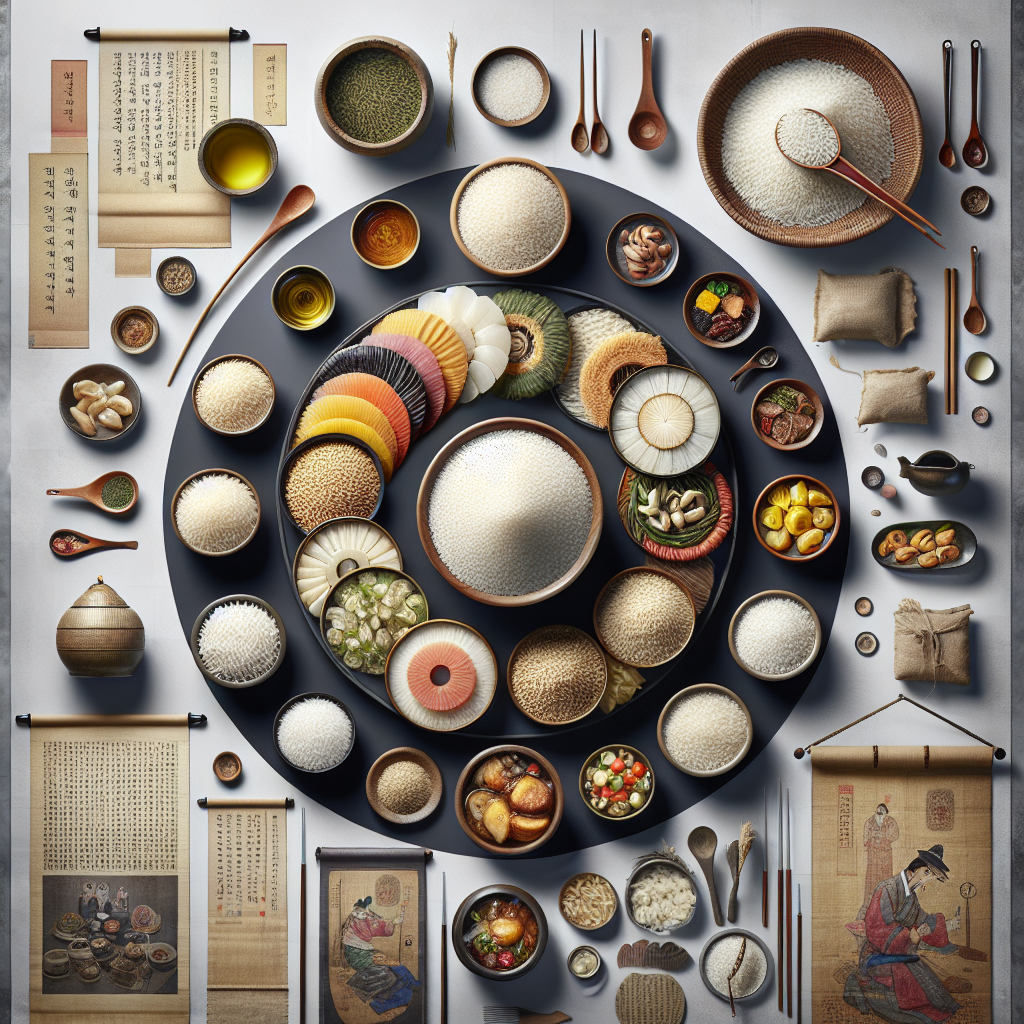In traditional Korean meals, rice holds a central position of importance. It is not just a simple side dish, but rather the heart and soul of the entire meal. Rice, or “bap” in Korean, is more than just a source of sustenance; it is deeply rooted in the country’s culture and history. For Koreans, rice symbolizes wealth, abundance, and the essence of daily life. Whether it is steamed, fried, or used to make rice cakes, rice plays a fundamental role in Korean cuisine, bringing together flavors, textures, and traditions that have been passed down through generations. So, let’s explore the rich significance of rice in traditional Korean meals!
Historical Background
Origins of rice cultivation in Korea
Rice cultivation has a long history in Korea, dating back to around 1500 BCE. It is believed that the practice of rice cultivation was introduced to the Korean peninsula from China through migration and trade. The unique climate and fertile soil provided ideal conditions for rice cultivation, leading it to become a staple food in Korean cuisine.
Importance of rice in Korean culture
Rice holds great significance in Korean culture, going beyond its role as a food staple. It is considered a vital part of Korean identity and is deeply ingrained in the country’s traditions and customs. Rice is seen as a symbol of sustenance and abundance, representing prosperity and good fortune. It holds a special place in Korean ceremonies and is often used in rituals and offerings.
Rice as a Staple Food
Role of rice as the main source of nutrition
In traditional Korean cuisine, rice served as the main source of nutrition for the majority of the population. It is a carbohydrate-rich grain that provides essential energy and nutrients. Korean meals typically revolve around a bowl of rice, which is complemented by an array of side dishes and soups. The combination of rice with various ingredients ensures a balanced meal that satisfies hunger and provides sustenance.
Traditional methods of cooking rice
Traditionally, rice in Korea was cooked in a large iron pot called a “sot.” Water and rice were added proportionally, and the mixture was allowed to simmer over a low flame until the rice reached a fluffy and tender consistency. This method ensured that the rice cooked evenly and retained its natural flavors. While modern electric rice cookers are now commonly used, the traditional cooking method still holds a special place in Korean culture.

Rice Varieties
Different types of rice used in Korean cuisine
Korean cuisine features a variety of rice types, each with its own unique characteristics and purposes. The most common type is “bap,” which refers to plain, white rice. Other types include “heukmi,” a black rice variety known for its nutty flavor, and “japgokbap,” a mixed grain rice containing various types of grains such as barley, millet, and beans.
Popular rice varieties in traditional Korean meals
In traditional Korean meals, different rice varieties are used based on the occasion and preferences. “Yangban” rice, a premium and high-quality variety, was often reserved for nobles and the upper class. “Ilpumun” rice, on the other hand, was consumed by the common people and was known for its affordability without compromising taste and quality.
Rice as a Symbol
Rice as a symbol of abundance and prosperity
Rice has always been regarded as a symbol of abundance and prosperity in Korean culture. Its cultivation and consumption represent a bountiful harvest and the assurance of having enough food to sustain the community. Rice holds a deep cultural significance that extends beyond its nutritional value, serving as a representation of wealth and well-being.
Inclusion of rice in ceremonial meals
In ceremonial meals and rituals, rice plays a central role as a symbol of offering and respect. It is often presented in a ceremonial vessel called a “cheonryu,” symbolizing the highest quality and purity. Rice is also used to create intricate rice cakes, known as “songpyeon,” which are prepared and shared during festivities such as Chuseok, the Korean harvest festival.

Rice in Korean Side Dishes
Famous rice-based side dishes
Korean cuisine boasts a wide range of rice-based side dishes, known as “banchan.” These side dishes are typically served alongside rice, adding variety and flavor to the meal. One such dish is “bibimbap,” a colorful mixture of rice, vegetables, meat, and a spicy sauce. Another popular side dish is “jumukbap,” which consists of rice balls filled with seasoned ingredients such as vegetables, meat, or fish.
Recipes and preparation methods of rice side dishes
The preparation of rice-based side dishes varies greatly, showcasing the diversity of Korean cuisine. For example, “gimbap” is made by rolling rice and various fillings in a sheet of seaweed. “Tteokbokki,” a beloved street food, combines rice cakes with a spicy sauce made from chili paste. These side dishes not only enhance the overall dining experience but also showcase the versatility and creativity of Korean cuisine.
Rice in Kimchi Making
Role of rice in making traditional kimchi
Rice plays a crucial role in the fermentation process of traditional kimchi. It is used to create a paste, known as “kimchi base,” that serves as the foundation for the famous Korean side dish. The rice paste acts as a binder, helping to adhere the flavors and ingredients together, while also adding a subtle sweetness to balance the spiciness of the kimchi.
Benefits of adding rice to kimchi
The addition of rice to kimchi offers multiple benefits. Firstly, it helps to maintain the texture and crunchiness of the vegetables during the fermentation process. Secondly, the natural sugars present in rice act as a food source for the beneficial bacteria, facilitating the fermentation and increasing the overall nutritional value of the kimchi. Lastly, the rice paste imparts a mild sweetness to the kimchi, balancing the tanginess and spice, resulting in a well-rounded flavor profile.

Rice in Korean Desserts
Rice-based desserts in Korean cuisine
Rice is a key ingredient in many traditional Korean desserts, offering a unique texture and flavor. One popular rice-based dessert is “patbingsu,” a shaved ice dessert topped with sweetened red beans, fruits, and rice cakes. “Songpyeon,” mentioned earlier, is not only a ceremonial food but also a delightful dessert made from rice flour, filled with sweet bean pastes or nuts.
Traditional rice cake varieties
Rice cakes, known as “tteok,” are a significant part of Korean culinary heritage. They come in various forms and flavors, including “injeolmi” (coated with roasted soybean powder), “tteokguk” (rice cake soup), and “gyungdan” (rice cake balls with sweet fillings). These rice cakes are enjoyed on special occasions such as Lunar New Year and weddings, and each variety holds cultural and symbolic meanings.
Rice in Korean Beverages
Traditional rice-based beverages
In addition to being a staple food, rice is also utilized in traditional Korean beverages. One popular rice-based drink is “sikhye,” a sweet and refreshing fermented rice beverage. Another traditional drink is “makkoli,” a milky and mildly alcoholic rice wine. These beverages not only quench thirst but also provide a glimpse into the rich Korean drinking culture.
Importance of rice in brewing traditional liquors
Rice plays a vital role in the brewing of traditional Korean liquors, such as “soju” and “makgeolli.” Soju, a distilled spirit, is made primarily from rice and has become the most popular alcoholic beverage in Korea. Makgeolli, on the other hand, is an unfiltered rice wine known for its creamy texture and slightly sour taste. Rice contributes to the fermentation process, imparting distinctive flavors and characteristics to these traditional liquors.

Health Benefits of Rice
Nutritional value of rice
Rice offers several health benefits due to its nutritional composition. It is a good source of complex carbohydrates, providing sustained energy and promoting satiety. Additionally, rice contains essential vitamins and minerals, including iron, magnesium, and B vitamins. The versatile nature of rice makes it a suitable dietary staple for individuals of all ages and dietary preferences.
Rice as a gluten-free option
For individuals with gluten sensitivities or celiac disease, rice serves as a safe and gluten-free alternative. Unlike wheat and other grains, rice does not contain gluten, making it a staple food in gluten-free diets. Rice can be enjoyed in various forms, allowing those with gluten intolerance to still partake in traditional Korean meals and experience the rich flavors of Korean cuisine.
Modern Usage of Rice
Integration of rice in modern Korean cuisine
While rice continues to be a fundamental component of traditional Korean meals, its usage has also evolved in modern Korean cuisine. Rice is now incorporated into fusion dishes and international cuisines, blending traditional flavors with contemporary culinary techniques. Creative rice dishes such as “bibimbap burgers” and “rice porridge risotto” highlight the adaptability of rice and its ability to fuse with diverse ingredients and cooking styles.
New inventions and fusion dishes with rice
The culinary world is constantly evolving, and this includes the realm of rice-focused dishes. Chefs and food enthusiasts are continuously experimenting with new inventions and fusion cuisines that incorporate rice in unique ways. From sushi-inspired rice rolls to rice-based pizzas, these innovative dishes demonstrate the versatility of rice and its ability to adapt to various culinary trends.
In conclusion, rice holds immense significance in traditional Korean meals, deeply rooted in the country’s history, culture, and culinary traditions. From its origins as a staple food to its role as a symbol of abundance and prosperity, rice has shaped Korean cuisine in numerous ways. Whether it is enjoyed as a main course, in side dishes, desserts, or beverages, rice continues to provide sustenance, flavor, and cultural identity in Korean culinary traditions.

